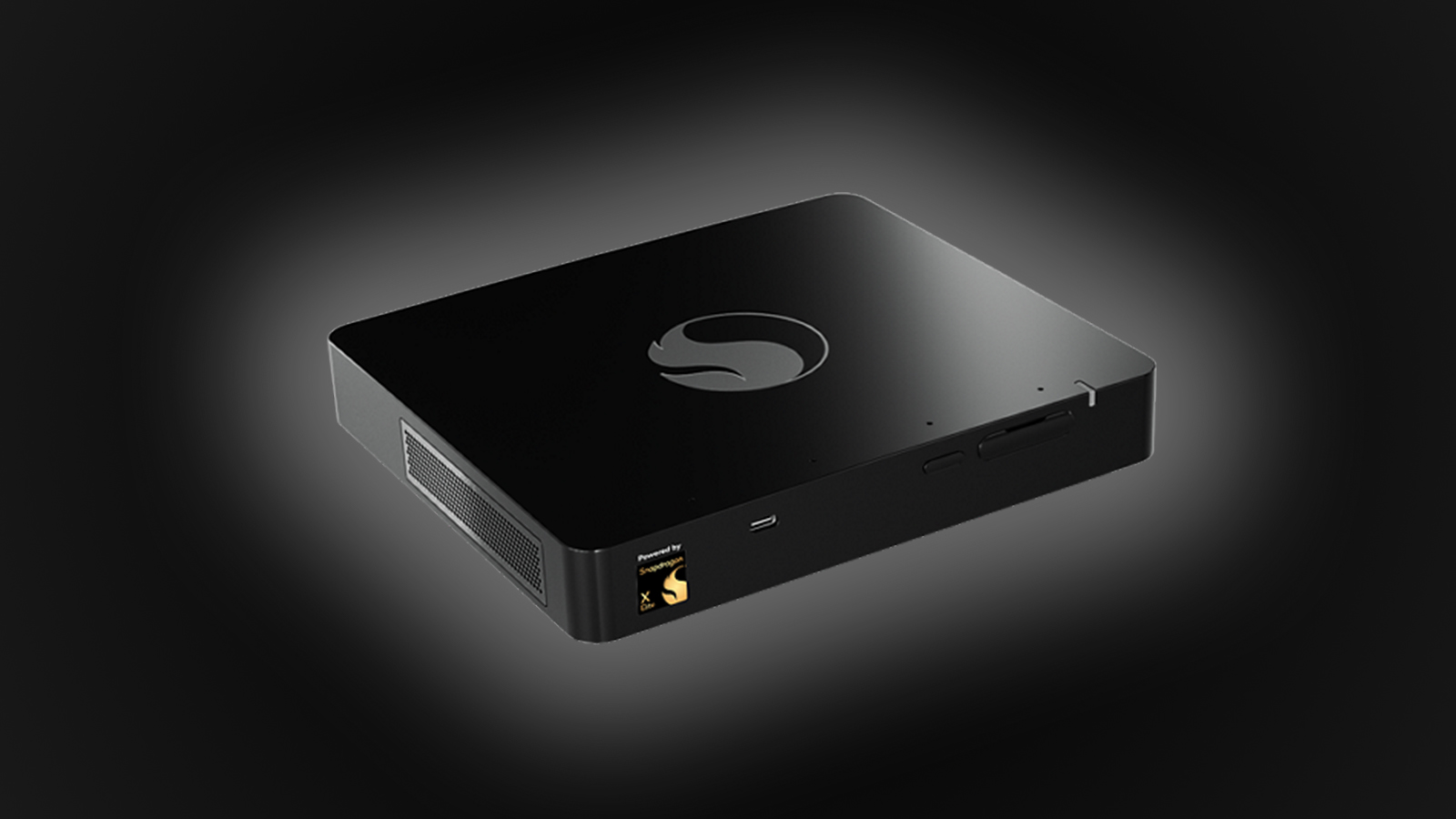Snapdragon X Elite Dev Kit is an $899 mini PC — meant to develop for Windows on Arm
A lower-cost means to develop for Windows on Arm

Qualcomm just announced the Snapdragon Dev Kit for Windows mini-PC to encourage developers to build more Arm-native apps for Windows 11. This comes shortly after several laptop makers launched Windows 11 laptops powered by Snapdragon X chips. Although these new chips offer better performance and battery life than top Intel and AMD laptop processors, Qualcomm’s Snapdragon X chip use the Arm architecture, which requires emulation to run x86 apps that many Windows PCs use.
According to Qualcomm’s product brief, a Snapdragon X Elite SoC powers this mini-PC, which boasts a 12-core 3.8-GHz Oryon CPU, an Adreno GPU, and a Hexagon NPU that can run up to 4.5 TOPS. It also has 32GB LPDDR5x RAM and a 512GB NVMe SSD. This small computer measures 8 x 7 x 1.3 inches, which puts it close enough to the size of a Mac mini. It also has a 3.5mm audio jack, three USB 4 Type-C, two USB 3.2 Type-A, an RJ45 ethernet, and an HDMI port — similar to what Apple offers in the M2 Mac mini.
However, this isn’t the first time that we received an Arm-powered Windows dev kit. Microsoft launched Project Volterra just last year: a developer box powered by the Snapdragon 8cx Gen 3 compute platform. Qualcomm also released a Snapdragon Develop Kit in 2021 to get more developers on board to build apps for Windows 10 on Arm.
Despite these efforts, Arm-powered Windows PCs still hasn’t reached mainstream success, unlike Apple which has completely transitioned to its own silicon in 2023. However, this is likely because of the lack of viable offerings from laptop makers. This could change this year, especially as many manufacturers, like Acer, Dell, HP, and Lenovo, have launched multiple models simultaneously. We even have an early review of Microsoft’s Snapdragon X Elite-powered Surface laptop by Signal65, which shows exceptional power and efficiency.
And while Signal65’s review showed a marked improvement with Microsoft’s new Prism translation layer, you will still sacrifice some performance if you don’t run apps natively. If the new Snapdragon X-powered devices turn out as successful as Apple-silicon powered laptops and desktops, many developers will be encouraged to create native versions of their x86 apps for these systems or even build programs that can only be run on Arm.
Nevertheless, you do not have to be a programmer to get the Snapdragon Dev Kit for Windows mini-PC. If you’re on the market for a desktop PC that doesn’t take up much space and want to be on the cutting edge of technology, you’re also free to purchase this device. According to Videocardz, the Qualcomm mini-PC will launch on June 18 for $899 — a great price considering all other recently-launched Snapdragon X-powered laptops go for $1,099 and up.
Get Tom's Hardware's best news and in-depth reviews, straight to your inbox.

Jowi Morales is a tech enthusiast with years of experience working in the industry. He’s been writing with several tech publications since 2021, where he’s been interested in tech hardware and consumer electronics.
-
Notton I'm not familiar with SDK costs, but as someone who has looked at many mini-PCs, it's about $150~170 too expensive.Reply
8845HS/8945HS mini-PC with 32GB RAM and 1TB SSD is around $750~800.
Hopefully someone else sells one for cheaper? (I can live without SDK tools) -
ThomasKinsley Reply
Quite a few of those mini PCs are made in China and tend to come with a modified BIOS and questionable practices. Qualcomm's main competitor is the Mac Mini, which apparently can't have 32GB of RAM. A 16GB variant with 512GB of storage is priced at $999, so Qualcomm is still cheaper. I certainly hope that we get more competition so ARM on Windows does not require Apple prices to enjoy it.Notton said:I'm not familiar with SDK costs, but as someone who has looked at many mini-PCs, it's about $150~170 too expensive.
8845HS/8945HS mini-PC with 32GB RAM and 1TB SSD is around $750~800.
Hopefully someone else sells one for cheaper? (I can live without SDK tools) -
JamesJones44 Reply
In most cases for software languages the SDKs are free. You can use .NET an cross build C++/C#/F# into ARM and x64 for free. Same with Go, Java, Electron (trying not to puke writing that), Flutter, etc. IDK if Qualcomm is selling something special SDK wise, but most developers shouldn't need it.Notton said:I'm not familiar with SDK costs, but as someone who has looked at many mini-PCs, it's about $150~170 too expensive.
8845HS/8945HS mini-PC with 32GB RAM and 1TB SSD is around $750~800.
Hopefully someone else sells one for cheaper? (I can live without SDK tools) -
Mecwee I am hoping someone can compare these ai pcs from qualcomm, amd and Intel. Architecture, developer friendly, performance, etc.?Reply -
kealii123 Its easy to compare this to other consumer mini PCs, but thats not the target audience. Its for developers.Reply
Personally, I'd buy one if it came with 64 gig of RAM so it could run the largest param LLama3 (that 45tflops is pretty good) but the intention is for developers to optimize their software on a platform that mimics what their users will have, which is going to be Qualcomm laptops with 16-32 gigs of RAM, and on the same chip.
This is not intended for consumers. -
bit_user At the $599 price point of Microsoft's Project Volterra, this would be super tempting if it natively booted Linux. However, at $899 starts to push it above my "toy" price range and I'm not quite ready to switch to ARM as my daily driver (absent other considerations, like laptop battery life).Reply
Competition, bro. Let's get more players in this market, because even though no one can probably compete with Qualcomm on performance, you can bet they'll considerably undercut them on price. For someone like me, I'd rather have a good laptop that's cheap than take out a second mortgage for the best laptop, only to have it superseded within a year.The article said:Despite these efforts, Arm-powered Windows PCs still hasn’t reached mainstream success, -
kealii123 Reply
Do you write software for Windows users? If you don't, this product isn't intended for you.bit_user said:At the $599 price point of Microsoft's Project Volterra, this would be super tempting if it natively booted Linux. However, at $899 starts to push it above my "toy" price range and I'm not quite ready to switch to ARM as my daily driver (absent other considerations, like laptop battery life).
Competition, bro. Let's get more players in this market, because even though no one can probably compete with Qualcomm on performance, you can bet they'll considerably undercut them on price. For someone like me, I'd rather have a good laptop that's cheap than take out a second mortgage for the best laptop, only to have it superseded within a year.
The vast majority of sales will be on a company, not personal, credit card. -
bit_user Reply
I am speaking about its value proposition, as a mini-PC. As for the "Windows" part, didn't you hear that Qualcomm is leaning into Linux support?kealii123 said:Do you write software for Windows users? If you don't, this product isn't intended for you.
https://www.tomshardware.com/software/linux/qualcomm-goes-where-apple-wont-readies-official-linux-support-for-snapdragon-x-elite
So, if this dev kit is coming from Qualcomm and not Microsoft, then it's quite likely they'll be supporting Linux on it!
As long as they don't prohibit private sales, it can be regarded as being on the open market.kealii123 said:The vast majority of sales will be on a company, not personal, credit card. -
Findecanor I like this form factor. In the past I have used either an EeeBox or a Mac Mini as my main computer (running Linux).Reply
Apart from horsepower and upgrades, I have learned that they really should have USB A and a headphone jack on the front.
Having those readily accessible at desktop height provides the best usability. You don't want to rummage around the back.
The EeeBox was also vertical on a grippy and weighty foot that kept it in place.
Qualcomm: Please iterate and release a cheaper consumer version that have that! -
bit_user Reply
You might be able to replicate this by using a rubber mat.Findecanor said:The EeeBox was also vertical on a grippy and weighty foot that kept it in place.
They won't. Qualcomm makes reference devices and development kits, but leaves it up to their partners to cater to specific consumer needs.Findecanor said:Qualcomm: Please iterate and release a cheaper consumer version that have that!